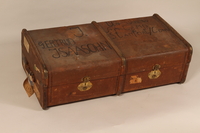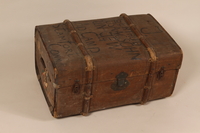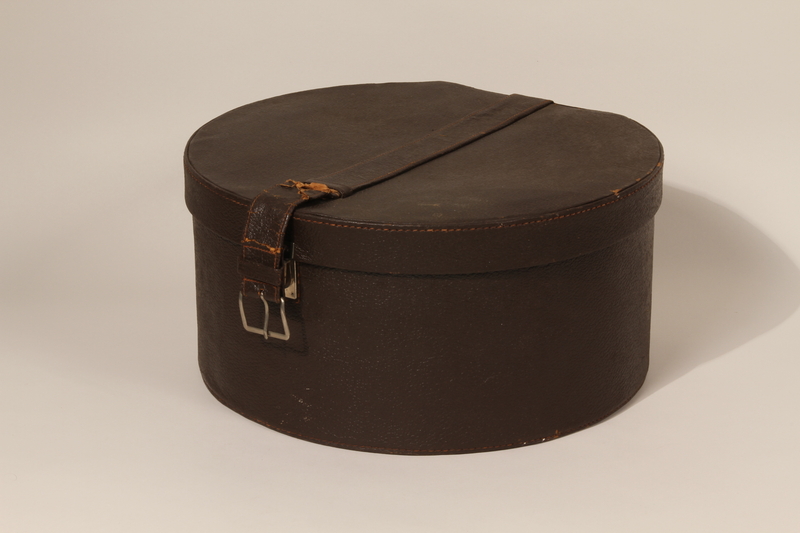Overview
- Brief Narrative
- Large, brown imitation leather hatbox used by 16 year old Dorit Isaacsohn and her mother Gertrud during their November 1949 emigration from Berlin, Germany, to the United States. By the late 1930’s, Dorit’s parents had lost their livelihood because of the anti-Semitic policies of the Nazi regime. Dorit, age 6, was sent to Brussels on a Kindertransport in 1939. Germany invaded Belgium in May 1940 and Dorit was returned to her parents in Berlin in 1941. On February 27, 1943, Dorit and her family had to separate to go into hiding. Dorit stayed with a family friend, a cousin, and her father Julius in Berlin. In fall 1943, Dorit left Berlin to live with her mother at a farm in Wilkersdorf. Shortly after, her father was betrayed by his nephew Rolf and deported to Auschwitz-Birkenau on October 23, where he was killed. Dorit and her mother traveled around eastern Germany until January 1945, when they were liberated by Soviet forces in Wilkersdorf.
- Date
-
use:
1949 November
- Geography
-
received:
Berlin (Germany)
manufacture: Germany
- Credit Line
- United States Holocaust Memorial Museum Collection, Gift of Dorit Isaacsohn
- Markings
- base front, metal plate, engraved : TURNYT / IKA No 1750 / (key) No 1751 / MADE IN GERMANY
- Contributor
-
Subject:
Dorit Isaacsohn
Manufacturer: Turnyt
- Biography
-
Dorothea (Dorit) Isaacsohn (later Dorothy Isaacsohn, 1933-2008) was born in Berlin, Germany, to Julius and Gertrud Koh Isaacsohn. Julius (1891-1943) was born in Berlin to Herrman Benjamin and Ernestine Kaiser Isaacsohn. Julius was a garment maker and coat and suit designer who imported his own fabrics. Gertrud (1901-1978) was born in Gratz, Germany (Grodzisk Wielkopolski, Poland), to Alex and Dorothea Koh. In May 1931, Julius and Gertrud married. Gertrud had a dressmaking business in their apartment and employed a non-Jewish woman, Lucie Gardner. They made a good living, lived in a predominantly Jewish area, and attended a large synagogue.
The Nazi regime had taken power shortly before Dorit’s birth and actively began persecuting Jews. Gertrud’s employee Lucie was no longer allowed to work for a Jewish woman. In 1938, Julius and Gertrud lost their jobs. In early 1939, Dorit’s parents attempted to leave Germany, but could not get visas and permits. They sent 6 year old Dorit to Brussels, Belgium, to live with Dorit’s maternal aunt, Anna Kaufman, and her husband and stepson. Dorit’s maternal uncle Ludwig also lived in Brussels. Dorit had diphtheria when she arrived and was hospitalized, before going to live with her aunt Anna. The war began when Germany invaded Poland on September 1, 1939. Shortly after, on May 10, 1940, Germany invaded Belgium. Three German soldiers came to the apartment of Dorit’s aunt and took both of her uncles away. In 1941, Dorit returned to Berlin with the help of her parents and a family friend. In Berlin, Julius and Gertrud were forced to share their apartment with displaced Jewish families. Her parents were forced to work for the German government: Gertrud at a factory sewing leather army goods, and Julius at a lumber yard.
Gertrud heard there was going to be a large roundup of Jews so on February 27, 1943, Dorit and her parents went into hiding with non-Jewish friends. Gertrud and Julius found an apartment to rent under the false name Schultz, but they had no false papers to support that claim. When they arrived, the owner refused to let them stay and the family separated. Dorit stayed with Lucie Gardner, Gertrud’s former employee, who told neighbors that Dorit was her niece. In April or May, Dorit moved into a crowded apartment with her cousin Rolf Isaacsohn, his girlfriend, Stella Goldschlag Kubler, and seven others. One summer day, Rolf and Dorit were told that Stella had been arrested by the Gestapo. Shortly after, Dorit went to live with her father Julius in the home of an apartment building janitor.
Dorit’s mother Gertrud had left Berlin and worked as a traveling private dressmaker. She told her clients that her home had been bombed and her husband was in the army. Gertrud was living at a farm in Wilkersdorf (Krzesnica, Poland) and asked the farmer to allow Dorit to live there. The farmer agreed if Dorit brought stamps for sugar, so Julius purchased the stamps on the black market. In October 1943, Dorit went to Wilkersdorf. When they returned to Berlin for another job, they were told that Dorit’s cousin Rolf had begun working for the Gestapo and had betrayed Julius, who was arrested. Gertrud and Dorit traveled around Germany working for different clients, including the head of the Gestapo. In December 1944, they returned to Wilkersdorf to make a wedding dress for a client. In early January 1945, Soviet forces liberated the town. The Soviets demanded that the Germans march eastward, so Dorit and Gertrud walked for days, taking food from empty houses. The war ended when Germany surrendered on May 7, 1945.
Dorit, Gertrud, and the other German refugees were forced to leave, as the area they were staying in was now Poland. While walking back to Berlin, they were unable to bathe and Dorit contracted lice and was covered in contagious sores. They arrived in July and resumed using the last name Isaacsohn. Gertrud registered with the Jewish community, but found no relatives on the survivors list. Gertrud was placed in a displaced persons camp, and Dorit was put in the Jewish hospital because of the sores. She asked concentration camp survivors if they knew her father, but no one did. Later, they learned that on October 29, 1943, Julius had been sent to Auschwitz-Birkenau killing center in German-occupied Poland, on transport 45, and was killed. Dorit’s maternal uncle Ludwig survived several concentration camps, but the rest of their family perished. In late 1945, Gertrud was sick, so Dorit was sent to Lüneburg, Germany, and attended school for the first time. In summer 1946, she returned to Gertrud, who was healthy and had an apartment and a job as a dressmaker. They learned that during the war, Dorit’s cousin Rolf had tried to turn them over to the Gestapo, but could not find them. He escaped after the war, and left his wife Stella to be captured and tried as a collaborator by the Soviets. On October 25, 1949, Gertrud and Dorit immigrated to the United States on the USAT General Ballou. They settled in Easton, Pennsylvania. Sixteen year old Dorit changed her name to Dorothy but continued to go by Dorit. She was told she was too old to attend school, so she went to hairdressing school because she had taken an ORT course on cosmetics in Germany. Dorit worked as a hairdresser while Gertrud worked in a clothing factory and did alterations in a men’s clothing store. In 1952, they moved to Philadelphia.
Physical Details
- Language
- English
- Classification
-
Containers
- Category
-
Boxes
- Object Type
-
Hatboxes (lcsh)
- Physical Description
- Circular cardboard hatbox with a flat back edge, covered with dark brown imitation leather made from treated paper. The shallow lid was attached with a cardboard hinge and has a long imitation leather strap with a metal buckle inserted in the top back edge. The strap crosses the top center and threads through a loop near the front. On the front is a metal tuck catch, engraved with decorative lines with a center keyhole. On the front of the base is a metal plate with a U shaped bar for the catch. An imitation leather belt loop is stitched on the bottom near the front, with faded marks from a missing strap. The interior is lined with thin cardboard covered with brown cloth, with an additional square reinforcing the back edge. There are 4 dark brown cloth straps inserted into the seam at the bottom edge. The hardware is silver colored metal. The lid is now detached from the base.
- Dimensions
- overall: Height: 8.250 inches (20.955 cm) | Width: 16.625 inches (42.228 cm) | Depth: 16.375 inches (41.593 cm)
- Materials
- overall : paper, cardboard, paper, cloth, metal, adhesive, thread
Rights & Restrictions
- Conditions on Access
- No restrictions on access
- Conditions on Use
- No restrictions on use
Keywords & Subjects
- Topical Term
- Hidden children (Holocaust)--Germany--Berlin--Biography. Holocaust survivors--United States--Biography. Holocaust, Jewish (1939-1945)--Germany--Berlin--Personal narratives. Jewish children in the Holocaust--Germany--Berlin--Biography. Jewish refugees--United States--Biography. Jews--Persecution--Germany--Biography.
Administrative Notes
- Legal Status
- Permanent Collection
- Provenance
- The hatbox was donated to the United States Holocaust Memorial Museum in 2003 by Dorit Isaacsohn.
- Funding Note
- The cataloging of this artifact has been supported by a grant from the Conference on Jewish Material Claims Against Germany.
- Record last modified:
- 2022-07-28 18:28:34
- This page:
- https://collections.ushmm.org/search/catalog/irn514176
Also in Dorit Isaacsohn family collection
The collection consists of a hatbox, two trunks, a coin, and photographs relating to the experiences of Dorit Isaacsohn, her parents Gertrud and Julius, and other family members before the Holocaust in Gratz and Berlin, Germany, which Dorit and Gertrud survived in hiding, and after the Holocaust in Berlin and the United States.
Date: approximately 1930-1949

Brown burlap covered trunk used postwar by a young German Jewish refugee
Object
Brown burlap covered plywood trunk used by 16 year old Dorit Isaacsohn and her mother Gertrud during their November 1949 emigration from Berlin, Germany, to the United States. By the late 1930’s, Dorit’s parents had lost their livelihood because of the anti-Semitic policies of the Nazi regime. Dorit, age 6, was sent to Brussels on a Kindertransport in 1939. Germany invaded Belgium in May 1940 and Dorit was returned to her parents in Berlin in 1941. On February 27, 1943, Dorit and her family had to separate to go into hiding. Dorit stayed with a family friend, a cousin, and her father Julius in Berlin. In fall 1943, Dorit left Berlin to live with her mother at a farm in Wilkersdorf. Shortly after, her father was betrayed by his nephew Rolf and deported to Auschwitz-Birkenau on October 23, where he was killed. Dorit and her mother traveled around eastern Germany until January 1945, when they were liberated by Soviet forces in Wilkersdorf.

Square, brown burlap covered trunk used postwar by a young German Jewish refugee
Object
Brown cloth covered trunk used by 16 year old Dorit Isaacsohn and her mother Gertrud during their November 1949 emigration from Berlin, Germany, to the United States. By the late 1930’s, Dorit’s parents had lost their livelihood because of the anti-Semitic policies of the Nazi regime. Dorit, age 6, was sent to Brussels on a Kindertransport in 1939. Germany invaded Belgium in May 1940 and Dorit was returned to her parents in Berlin in 1941. On February 27, 1943, Dorit and her family had to separate to go into hiding. Dorit stayed with a family friend, a cousin, and her father Julius in Berlin. In fall 1943, Dorit left Berlin to live with her mother at a farm in Wilkersdorf. Shortly after, her father was betrayed by his nephew Rolf and deported to Auschwitz-Birkenau on October 23, where he was killed. Dorit and her mother traveled around eastern Germany until January 1945, when they were liberated by Soviet forces in Wilkersdorf.
Nazi Germany, 10 reichspfennig coin brought with a young German Jewish refugee
Object
German 10 pfennig coin brought with 16 year old Dorit Isaacsohn and her mother Gertrud during their November 1949 emigration from Berlin, Germany, to the United States. By the late 1930’s, Dorit’s parents had lost their livelihood because of the anti-Semitic policies of the Nazi regime. Dorit, age 6, was sent to Brussels on a Kindertransport in 1939. Germany invaded Belgium in May 1940 and Dorit was returned to her parents in Berlin in 1941. On February 27, 1943, Dorit and her family had to separate to go into hiding. Dorit stayed with a family friend, a cousin, and her father Julius in Berlin. In fall 1943, Dorit left Berlin to live with her mother at a farm in Wilkersdorf. Shortly after, her father was betrayed by his nephew Rolf and deported to Auschwitz-Birkenau on October 23, where he was killed. Dorit and her mother traveled around eastern Germany until January 1945, when they were liberated by Soviet forces in Wilkersdorf.





